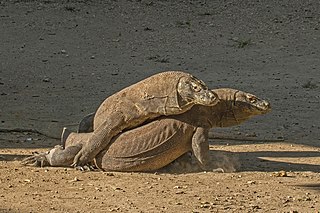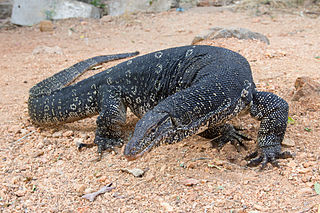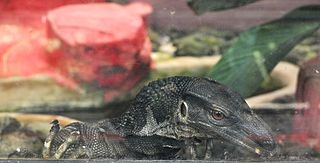
The Varanidae are a family of lizards in the superfamily Varanoidea within the Anguimorpha group. The family, a group of carnivorous and frugivorous lizards, includes the living genus Varanus and a number of extinct genera more closely related to Varanus than to the earless monitor lizard (Lanthanotus). Varanus includes the Komodo dragon, crocodile monitor, savannah monitor, the goannas of Australia and Southeast Asia, and various other species with a similarly distinctive appearance. Their closest living relatives are the earless monitor lizard and chinese crocodile lizard. The oldest members of the family are known from the Late Cretaceous of Mongolia.

Monitor lizards are lizards in the genus Varanus, the only extant genus in the family Varanidae. They are native to Africa, Asia, and Oceania, and one species is also found in the Americas as an invasive species. About 80 species are recognized.

Megalania is an extinct species of giant monitor lizard, part of the megafaunal assemblage that inhabited Australia during the Pleistocene. It is the largest terrestrial lizard known to have existed, reaching an estimated length of 3.5 to 7 metres, and weighing between 97–1,940 kg (214–4,277 lb), but the fragmentary nature of known remains make estimates highly uncertain.

The Nile monitor is a large member of the monitor family (Varanidae) found throughout most of Sub-Saharan Africa and along the Nile, with invasive populations in North America. The population in West African forests and savannahs is sometimes recognized as a separate species, the West African Nile monitor. It is one of the largest lizards in the world reaching and even surpassing the perentie by size. Other common names include the African small-grain lizard, as well as iguana and various forms derived from it, such as guana, water leguaan or river leguaan. A feral population of the lizards, descended from escaped or intentionally released pets, has become established in several locations in Florida.

The Bengal monitor, also called the common Indian monitor, is a monitor lizard distributed widely in the Indian Subcontinent, as well as parts of Southeast Asia and West Asia. This large lizard is mainly a terrestrial animal, and its length ranges from about 61 to 175 cm from the tip of the snout to the end of the tail. Young monitors may be more arboreal, but adults mainly hunt on the ground, preying mainly on arthropods, but also taking small terrestrial vertebrates, ground birds, eggs and fish. Although large Bengal monitors have few predators apart from humans who hunt them for meat, younger individuals are hunted by many predators.

The desert monitor is a species of monitor lizard of the order Squamata found living throughout North Africa and Central and South Asia. The desert monitor is carnivorous, feeding on a wide range of vertebrates and invertebrates.

The Asian water monitor is a large varanid lizard native to South and Southeast Asia. It is one of the most common monitor lizards in Asia, ranging from coastal northeast India, Bangladesh, Sri Lanka, mainland Southeast Asia, and southern China to Indonesian islands where it lives close to water. It is listed as Least Concern on the IUCN Red List. It was described by Laurenti in 1768 and is among the largest squamates in the world.

Varanus salvadorii, also known as the crocodile monitor, Papuan monitor and Salvadori's monitor, is a species of monitor lizard endemic to New Guinea. It is the largest monitor lizard known from New Guinea, and is one of the longest lizards in the world, verified at up to 244 cm (96 in). The tail of the species is exceptionally long, so some specimens have been claimed to exceed the length of the world's largest lizard, the Komodo dragon; however, V. salvadorii is far less massive.

The yellow-spotted monitor, also known as the Argus monitor, is a monitor lizard found in northern and western regions of Australia and southern New Guinea.
Plasmodium clelandi is a parasite of the genus Plasmodium subgenus Carinamoeba.

The Anguimorpha is a suborder of squamates. The group was named by Fürbringer in 1900 to include all autarchoglossans closer to Varanus and Anguis than Scincus. These lizards, along with iguanians and snakes, constitute the proposed "venom clade" Toxicofera of all venomous reptiles.

Adeleorina is a suborder of parasites in the phylum Apicomplexa.

The clouded monitor is a species of monitor lizard, native to Burma, Thailand and Indochina to West Malaysia, Singapore, Java, and Sumatra. They are excellent tree climbers. It belongs to the subgenus Empagusia along with the Bengal monitor, the Dumeril's monitor and other monitor lizards. It had previously been listed as a subspecies of Varanus bengalensis by some herpetologists. It is a diurnal monitor.

The turquoise monitor is a species of monitor lizards found in Indonesia. Specifically, it is found on Halmahera Island and in the Maluku Islands.

The black roughneck monitor is a species of monitor lizard found in Southeast Asian countries of Thailand, Burma, and Malaysia. It is also found in Indonesia on Sumatra and islands of the Riau Archipelago It is sometimes known simply as the roughneck monitor. In Thailand is called h̄èā cĥāng.

The blue-tailed monitor, blue-tailed tree monitor or Kalabeck's monitor, is a monitor lizard of the Varanidae family. It belongs to the V. doreanus group of the subgenus Euprepiosaurus.

Saniwa is an extinct genus of varanid lizard that lived about 48 million years ago during the Eocene epoch. It is known from well-preserved fossils found in the Bridger and Green River Formations of Wyoming. The type species S. ensidens was described in 1870 as the first fossil lizard known from North America. Several other species have since been added, but their validity is uncertain. It is a close relative of Varanus, the genus that includes monitor lizards.
Aggregata is a genus of parasitic alveolates belonging to the phylum Apicomplexa.
Amblyomma gervaisi is a hard-bodied tick of the genus Amblyomma. The tick is a parasite of snakes, such as Naja naja, Python molurus species and monitor species such as Varanus ocellatus, Varanus yemenensis, Varanus benghalensis, Varanus griseus and many other Varanus species in southeastern Asia and Asia-minor. They exhibit sexual dimorphism. They can be found in Sri Lanka, India, Yemen, Saudi Arabia. It is a potential vector for Coxiella burnetii.















